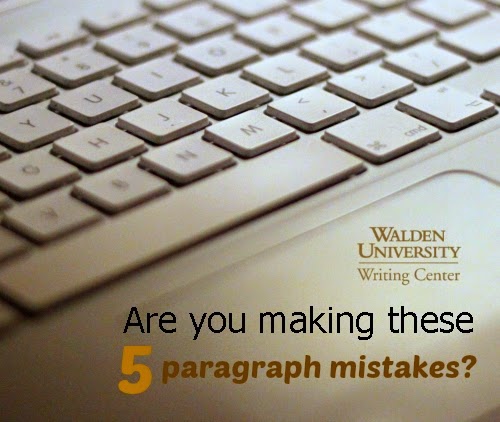Top 5 Paragraph-Level Mistakes in Student Writing
Often, Walden students ask for our feedback on APA style and grammar. However, in my experience, these issues are usually not the most important ones that need addressing in a student’s submitted piece of writing. Rather than sentence-level issues, global-level issues—such as those on the paragraph level—are going to make or break your paper. By “paragraph level,” I mean things that are not immediately evident in a single sentence but rather in the paragraph as a whole: organization, flow of ideas, use of logic and evidence, diversity of research, and absence of bias.Here are five of the most frequent paragraph-level issues I address as a writing instructor in paper reviews:
1. Paragraphs lacking the student’s own analysis.
Remember
that a paragraph should normally do more than merely summarize what other
scholars have said; instead, it should feature your own scholarly analysis and
arguments. To make this happen, APA and Walden recommend that each paragraph
begin with a main idea (expressed in
a topic sentence), followed by supporting evidence,
your own analysis of that evidence,
and end with a lead-out sentence that
concludes the paragraph’s argument. At the Writing Center, we often call this
paragraph structure the “MEAL” plan, which stands for the four components in
bold above. For more information, check out our four-part blog series on using the MEAL plan for paragraph organization and development.
2. Paragraphs that cite only one source.
Unless
your course instructor indicates otherwise, each paragraph should typically contain a
minimum of two cited sources, and preferably three to five. If your paragraph only
has one cited source, you are merely summarizing a source rather than
conducting scholarly analysis, and failing to show diversity of research.
3. Paragraphs that start with another researcher’s ideas, rather than the student’s.
When
beginning a new paragraph, we recommend starting with a topic sentence, which states the main idea of your paragraph with your own ideas and in your own words (meaning that you
should not need to include a citation). Ideally, you want your readers to
be able to summarize your paper simply by reading the first sentence of each
paragraph. For more information, see the Writing Center’s webpage on writing topic sentences.
4. Paragraphs that are too packed or crowded.
In
episode 3 of the Walden Writing Center’s WriteCast podcast,
we call these paragraphs the “whole paper" paragraphs. Trying to cram too many ideas into a
single paragraph will not only confuse your readers, but also potentially cause
your writing to become off-track and unfocused. If you find yourself addressing
more than one main idea or argument, either cut out the extra material or use
it in a new paragraph.
5. Paragraphs that fail to directly focus on a single idea or argument.
Make
sure that whatever you write in the paragraph directly supports the paragraph's topic sentence (see #3 above), which will help prevent the "whole paper" paragraph issue. Often, this requires zooming out to a bird’s-eye
view and explaining what a quotation or a particular point means and how it relates to your topic.
For more on writing strong paragraphs and paragraph mistakes to avoid, consider listening to episode 3 of our WriteCast
podcast. Or, view our archived “WritingEffective Academic Paragraphs” webinar.
.png)
Nik Nadeau, a writing instructor in the Walden University Writing Center, has been reviewing student papers since 2011. Nik also co-hosts WriteCast, the Writing Center's podcast.
.png)
Never miss a new post; Opt-out at any time
Practice: Spend the next 10 minutes reflecting on your own writing. Do you see any of the paragraph-level issues in your own work? Share your reflection in the comments, and don’t forget to give feedback to fellow writers.
.png)
Nik Nadeau, a writing instructor in the Walden University Writing Center, has been reviewing student papers since 2011. Nik also co-hosts WriteCast, the Writing Center's podcast.
.png)
Never miss a new post; Opt-out at any time
Subscribe to:
Post Comments
(
Atom
)




Nice article! I will definitely be mindful of these points when writing my papers and discussion posts.
ReplyDeleteThanks for reading, Nicole!
DeleteYou offered some great tips. I read the other blogs on the MEAL plan as well. However, are there any other resources with examples?
ReplyDeleteRichard
Please keep sharing more posts.
ReplyDeleteHi, Angel! We will definitely be sharing more posts :) We publish a new post every Monday, so you can check back here each week for new tips and advice. You can also subscribe via email (click the orange "Send me new posts" button at the bottom of a post) so that new posts come directly to your email inbox.
DeleteThanks for reading and commenting!
Good post.
ReplyDelete